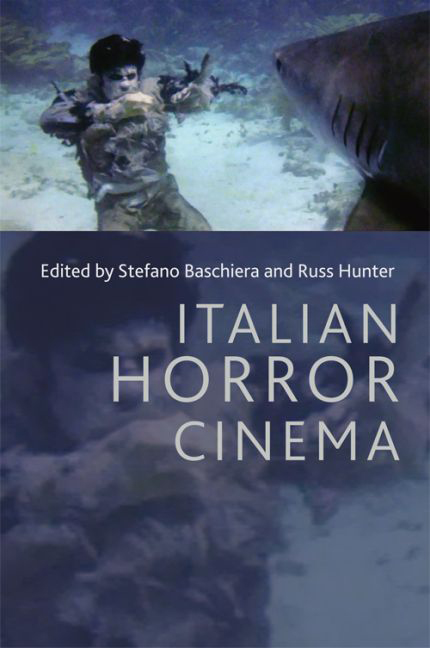Book contents
- Frontmatter
- Contents
- List of figures
- List of contributors
- Acknowledgements
- Introduction
- 1 Preferisco l'inferno: early Italian horror cinema
- 2 Domestic films made for export: modes of production of the 1960s Italian horror film
- 3 The 1980s Italian horror cinema of imitation: the good, the ugly and the sequel
- 4 Knowing the unknown beyond: ‘Italianate’ and ‘Italian’ horror cinema in the twenty-first century
- 5 Bavaesque: the making of Mario Bava as Italian horror auteur
- 6 The Argento Syndrome: aesthetics of horror
- 7 Scrap metal, stains, clogged drains: Argento's refuse and its refusals
- 8 The giallo /slasher landscape: Ecologia del delitto, Friday the 13th and subtractive spectatorship
- 9 Kings of terror, geniuses of crime: giallo cinema and fumetti neri
- 10 Political memory in the Italian hinterland: locating the ‘rural giallo’
- 11 The horror of progressive rock: Goblin and horror soundtracks
- 12 ‘The only monsters here are the filmmakers’: animal cruelty and death in Italian cannibal films
- 13 Italian horror cinema and Italian film journals of the 1970s
- Index
6 - The Argento Syndrome: aesthetics of horror
Published online by Cambridge University Press: 12 September 2017
- Frontmatter
- Contents
- List of figures
- List of contributors
- Acknowledgements
- Introduction
- 1 Preferisco l'inferno: early Italian horror cinema
- 2 Domestic films made for export: modes of production of the 1960s Italian horror film
- 3 The 1980s Italian horror cinema of imitation: the good, the ugly and the sequel
- 4 Knowing the unknown beyond: ‘Italianate’ and ‘Italian’ horror cinema in the twenty-first century
- 5 Bavaesque: the making of Mario Bava as Italian horror auteur
- 6 The Argento Syndrome: aesthetics of horror
- 7 Scrap metal, stains, clogged drains: Argento's refuse and its refusals
- 8 The giallo /slasher landscape: Ecologia del delitto, Friday the 13th and subtractive spectatorship
- 9 Kings of terror, geniuses of crime: giallo cinema and fumetti neri
- 10 Political memory in the Italian hinterland: locating the ‘rural giallo’
- 11 The horror of progressive rock: Goblin and horror soundtracks
- 12 ‘The only monsters here are the filmmakers’: animal cruelty and death in Italian cannibal films
- 13 Italian horror cinema and Italian film journals of the 1970s
- Index
Summary
The Argento Syndrome is my term for discussing filmmaker Dario Argento's consistent, even obsessive, explorations on film of the nature and effects of creating and viewing violence. Argento's films are an unrelenting investigation of the cinematic uses of memory, trauma and distorted vision, and the cinematic body as threatened site of attack, mutilation and death. The films are symptomatic of a politics and aesthetics that invoke the powers of internalised and externalised forms of horror, particularly tied to the twentieth century and to the uses of media technology, including computer-generated effects. In their blurring of fact and fantasy, challenges to representation, hallucinatory quality and particular strategies to incorporate the viewer into their images, they address a world where the real and illusory have lost their clarity and where art is as dangerous as life. Argento is a filmmaker whose cinematic work is very self-conscious of the uses of horror ‘as a meditation on the aesthetics of filmmaking itself’ (Schneider, 2007: 60).
In the early years of its development from the 1890s to the First World War, Italian cinema was identified with comedy films, romances, divismo (star films) and historical spectacles. However, the effects of fascism and war from the mid-1920s to the fall of the regime in 1943 introduced conflicts over the direction of film production in the immediate post-Second World War era. These centred around what came to be identified nationally and internationally as neorealism, with its focus on the effects of the war, the hardships of everyday survival, and the emphasis on humanist solidarity in contrast to the propagandistic and Hollywood-style films identified with the cinema of the twenty years of fascism (Bertellini, 2004: 4). Neorealism offered a version of cinema averse to genre forms, but, in fact, in the cinema ‘no profound cultural and/or political break occurred’ (Ricci, 2008: 165–8).
In the late 1950s into the 1970s, a blend of genre and neorealism emerged in popular comedic and melodramatic forms. In the industry's pressure to produce a profitable cinema of quality and of popularity, ‘historical’ and mythical peplum (costume) epics emerged and achieved local and international acclaim (subsequently to be overtaken by the popularity of Spaghetti Westerns).
- Type
- Chapter
- Information
- Italian Horror Cinema , pp. 93 - 110Publisher: Edinburgh University PressPrint publication year: 2016



